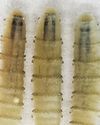Science

How It Works UK
UNCANNY'S DANNY ROBINS
The creator and host of the BBC's Uncanny series tells us about his most chilling experiences while researching the show, and writing a ghost book for children
4 min |
Issue 208

How It Works UK
HOW FEATHERS GROW
A bird's proteinaceous plumage comes from the same source as our hair
1 min |
Issue 208

How It Works UK
New EV battery technology could power 500-mile road trips on a 12-minute charge
Scientists have used a neat chemistry trick to tackle a major challenge facing future batteries.
2 min |
Issue 208

How It Works UK
HOW AIR PURIFIERS WORK
These filtration devices clean a room's air of particles that can make a person sick
1 min |
Issue 208

How It Works UK
Chinese scientists hunt for alien radio signals in a 'potentially habitable' star system
TRAPPIST-1 is a red dwarf star located about 40 light years away that hosts seven Earth-sized rocky planets, with at least three orbiting in the habitable zone where liquid water could exist.
2 min |
Issue 208

How It Works UK
WHAT HAPPENS WHEN WE DIE?
Our bodies are vessels for life, but in death they undergo a cascade of chemical and biological changes
3 min |
Issue 208

How It Works UK
WHY ARE KEYBOARDS QWERTY?
There's a reason why this seemingly random arrangement of letters is widely used on keyboard layouts
1 min |
Issue 208

How It Works UK
A 'quasi-moon' discovered in Earth orbit may have been hiding for decades
A new paper describes a possible 'quasi-moon' of Earth, an interloping asteroid that may have been following our planet around for decades, undetected.
1 min |
Issue 208

How It Works UK
WHAT'S AN ANTI-DRONE GUN?
How these devices intercept and disable unmanned aerial vehicles
1 min |
Issue 208

How It Works UK
Dozens of mysterious blobs discovered inside Mars may be 'failed planets'
Giant impact structures, including the potential remains of ancient ‘protoplanets’, may be lurking deep beneath the surface of Mars.
2 min |
Issue 208

How It Works UK
10 PHENOMENA SCIENCE JUST CAN'T EXPLAIN
From strange lights in the sky to rocks that spontaneously glide across the ground, the mysteries scientists are trying to finally crack
10 min |
Issue 208

How It Works UK
FLYING A LONGRANGE SUPER JET
Is the JetZero blended-wing aircraft the future of commercial flight?
1 min |
Issue 208

How It Works UK
The US reports its first New World parasitic screw worm infection in decades
A person in Maryland has been confirmed to have an infection with the flesh-eating New World screwworm parasite, the first human case of the infection in the United States since the parasite was eradicated in the country over 60 years ago, according to the US Department of Health and Human Services (HHS).
2 min |
Issue 208

How It Works UK
Spiders keep fireflies as glowing prisoners that draw more prey to their webs
Nocturnal spiders have been filmed capturing fireflies and keeping them in their webs to attract more prey, even intermittently checking on them over the course of an hour.
1 min |
Issue 208

How It Works UK
ANIMAL LEADERS
From top-dog wolves and wise elder elephants to insect royalty and sex-changing fish, animal alphas take many fascinating forms
2 min |
Issue 208

How It Works UK
INSIDE YOUR PC
Take a look inside a modern desktop computer to see how PCs have evolved over the years
2 min |
Issue 208

How It Works UK
CAN EXERCISE REDUCE STRESS?
Why moving about more can make you feel calmer and think clearer
2 min |
Issue 208

How It Works UK
NEXT-GENERATION NUCLEAR REACTOR
Could molten thorium be the future of nuclear power?
2 min |
Issue 208
How It Works UK
The iconic winged lion statue in Venice may be from China's Tang dynasty
A bronze statue of a winged lion that has long graced the centre of Piazza San Marco in Venice is from a faraway land, according to a new study.
2 min |
Issue 208

How It Works UK
HOW TO BE A GHOST HUNTER
We delve into the science and psychology behind the paranormal to ask... do ghosts exist?
3 min |
Issue 208

How It Works UK
HOW HAIR GROWS
Dear HIW. Would my hair grow longer without cutting it for a year or by getting small bits cut off regularly? Does this help it grow quicker?
1 min |
Issue 208

How It Works UK
DO YOU BELIEVE IN GHOSTS?
REAL GHOST STORIES FROM THE HOST AND CREATOR OF BBC'S UNCANNY
4 min |
Issue 208

How It Works UK
'Queen of icebergs' A23a is no longer the world's biggest
An iceberg that was once the size of Rhode Island and the biggest in the world has lost about 80 per cent of its mass since May, scientists at the British Antarctic Survey (BAS) report.
2 min |
Issue 208

How It Works UK
HOW THE FIRST TV SIGNAL WAS TRANSMITTED
A century ago, John Logie Baird demonstrated a working television transmission
1 min |
Issue 208
How It Works UK
INSIDE TRUMP'S 'PALACE IN THE SKY'
This luxurious intercontinental jumbo jet will be the US president's new Air Force One
3 min |
Issue 206
How It Works UK
Why are we still sending probes to Mars?
Mars is perhaps the most interesting, and certainly the most Earth-like world in the Solar System, and there's a huge amount still to find out about it.
1 min |
Issue 206

How It Works UK
BURMESE PYTHONS HAVE CELLS THAT HELP THEM DIGEST ENTIRE SKELETONS
Researchers found that specialised cells in Burmese pythons' intestinal lining process calcium from the bones of their meals. This helps explain how these predators digest whole prey.
1 min |
Issue 206

How It Works UK
DISCOVERING THE TITANIC
Finding the remains of this iconic liner on the seabed was no easy feat, but after more than seven decades the wreckage revealed itself
6 min |
Issue 206
How It Works UK
Melting glaciers could trigger volcanic eruptions around the globe
Melting glaciers could make volcanic eruptions more explosive and frequent, worsening climate change in the process, scientists have warned. Hundreds of volcanoes in Antarctica, Russia, New Zealand and North America rest beneath glaciers. But as the planet warms and these ice sheets melt and retreat, these volcanoes are likely to become more active, according to the authors of a new study analysing the activity of six volcanoes in southern Chile during the last ice age. “Glaciers tend to suppress the volume of eruptions from the volcanoes beneath them. But as glaciers retreat due to climate change, our findings suggest these volcanoes go on to erupt more frequently and more explosively,” said Pablo Moreno Yaeger, a graduate student at the University of Wisconsin-Madison.
2 min |
Issue 206

How It Works UK
The world's dams hold so much water they've shifted Earth's poles
The construction of thousands of dams since 1835 has caused Earth's poles to wobble, new research suggests. Scientists found that large dams hold so much water, they redistribute mass around the globe, shifting the position of Earth's crust relative to the mantle, the planet's middle layer. Earth's mantle is gooey, and the crust forms a solid shell that can slide around on top of it. Weight on the crust that causes it to shift relative to the mantle also shifts the location of Earth's poles. \"Any movement of mass within the Earth or on its surface changes the orientation of the rotation axis relative to the crust, a process termed true polar wander,\" researchers wrote in the journal Geophysical Research Letters.
2 min |
